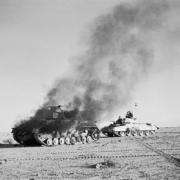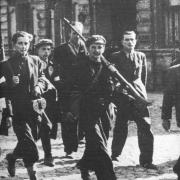In the spring of 1942 Soviet General S. K. Timoshenko led one of the Red Army's several attempts to wrest the initiative from the Germans in this case by launching an offensive from the Izyum salient and designed to destroy Germany's Army Group South and push on to Kiev.
Articles


On March 4th Marshal of the Soviet Union Georgy Zhukov's 1st Ukrainian Front, including the 3rd Guards Tank Army and 4th Tank Army, attacked German Army Group South's left wing and forged numerous penetrations in German defensive lines already heavily weakened following the battle for the Korsun pocket.

The failed Axis offensive at Kasserine Pass meant that by March of 1943 the Axis were doomed in North Africa. The Axis were trapped between two powerful armies and reliant on a logistical chain perpetually in crisis, as the Allies enjoyed overwhelming naval superiority and new air bases in Algeria and Libya to launch attacks on Axis shipping. The Axis had maneuvered a quarter of a million soldiers and huge stores of equipment and supplies into a dead end. General von Arnim, commanding Army

In December of 1939 the German surface raider and "pocket" battleship Admiral Graf Spee had finally been brought to battle by three cruisers from the British Royal Navy. Operating primarily in the South Atlantic during the fall of 1939 the Graf Spee sank numerous British merchantmen. However, the Royal Navy, after mobilizing significant assets to stop the Graf Spee, finally caught up with the German warship and after a running battle in which the Graf Spee sustained serious damage the Graf

Following Hitler's December 1941 declaration of war upon the United States German Admiral Karl Doenitz sought to take advantage of the weakly guarded sea-lanes near the American coast and pick off the highly vulnerable, solitary, merchant ships plying these waters. Hitler approved Doenitz's plan, code named Operation Paukenschlag, or drumbeat/roll the drums.

In mid-November 1941 Field Marshal Fedor von Bock's Army Group Center began the final phase of the German assault on Moscow spearheaded by the Third Panzer Army and Fourth Panzer Army. Some 233,000 men, 1,300 tanks, 1,880 guns and 800 aircraft efficiently split Rokossovsky's 16th Army and Leliushenko's 30th Army as the Germans hammered away at a similar number of Russian men and aircraft but far less guns and tanks; the Russian defenders could only put 1,254 guns and 502 tanks into the field.

In November 1941, a lull in the year long battle between the Axis and British Commonwealth forces fighting across the North African desert finally allowed both sides to recover their strength. German General Erwin Rommel's command fielded 414 tanks, 173 German, and nine divisions (including two German divisions; the 5th Light - renamed the 21st Panzer Division on October and 15th Panzer Division) with 320 aircraft providing direct close air support.
In October of 1942 the German Sixth Army, under General Friedrich Wilhelm Ernst Paulus, came as close as perhaps it ever did to defeating the Soviet defenders of Stalingrad - led most prominently by General Vasily Ivanovich Chuikov's 62nd Army. At best, by October 1942 the 62nd Army numbered 50,000 men and 80 tanks. According to those present it was nowhere near these numbers and the Germans held overwhelming advantages in men and machines.
In an assault beginning on October 14th, five German

Following the Third Reich's Anschluss, or political union, with Austria Hitler looked to Czechoslovakia for his next conquest. As a pretext for war the German media, under Goebbels direction, emitted a constant propaganda stream heightening tensions in the area by calling for protecting the German minority in Czechoslovakia. Goebbels agitations focused on the Sudetenland, a Czechoslovakian region running along the German border and home to most of Czechoslovakia's ethnic Germans.

Following the Red Army's stunning June-July 1944 defeat of Germany's Army Group Center, and the subsequent Soviet drive into Eastern Poland, one of the great tragedies of World War II unfolded in Warsaw. On August 1st 1944, the long-suffering Polish resistance and population, led by Polish Brigadier General Bor-Komorowski, launched a city wide uprising as the Red Army's 1st Belorussian Front approached Praga and crossed the Vistula.


